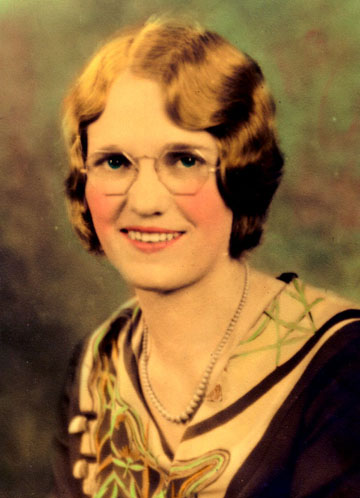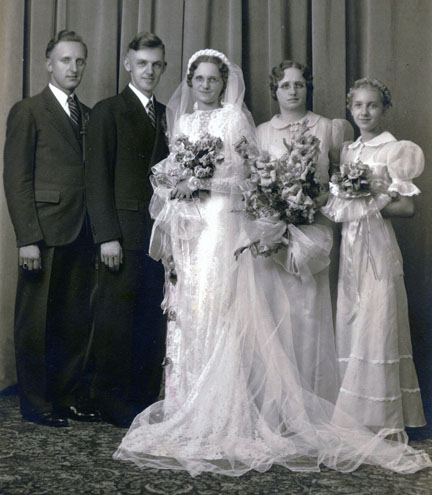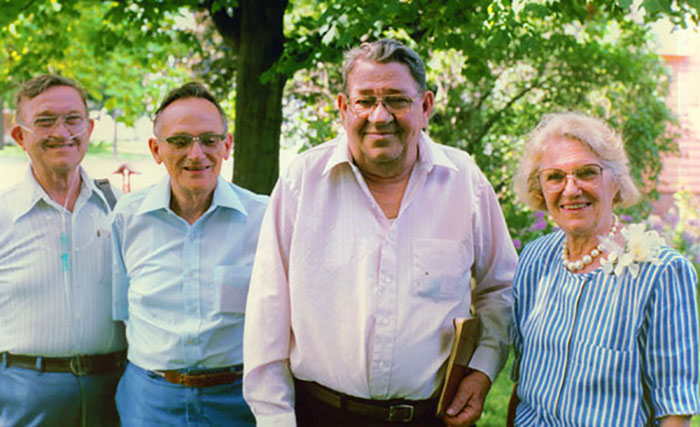|
Adelheid Erica Amanda Mueller Nickel
This brief biography was read during Adelheid’s memorial service at Calvary Lutheran Church in Stayton, Oregon.
Adelheid Erica Amanda Mueller Nickel was born in Madison, Minnesota, June 8, 1907. She was the fourth of Ernst and Helen Mueller’s nine children and, as she often pointed out, was thought to be the most delicate, the least likely to survive childhood. She died July 13, 1999, at age 92, with four children, eight grandchildren, and one great-grandchild.
Adelheid was the daughter of a Lutheran minister in a German-speaking community near Janesville, Minnesota. She learned her catechism in German, worshipped in German, and spoke German with friends and family — at least until World War I made it unwise to speak German outside the home. She was born Lutheran, raised Lutheran and was thoroughly Lutheran all her life — which meant, among other things, that Adelheid could handle contradictions.
She knew how important it was to keep up appearances. As a minister’s child, she worried that members of her father’s congregation would not approve of something she or her siblings said or did. So she behaved properly at all times ... and then again, she pushed a few limits. As a child, Adelheid scandalized the Ladies Aid by singing and dancing to that most sinful of songs, “Yes, We Have No Bananas.” It was Adelheid who was the first to wear bloomers, the risqué new fashion for active women. (Adelheid played basketball at college during the Roaring Twenties. She was considered tall enough to be a center.)
She was raised to have a deep, conservative respect for tradition, yet it was Adelheid who brought new, cosmopolitan, forward-thinking notions from the larger world back to southern Minnesota. Among other innovations, she liberated families from the tyranny of salted, dried or canned meat by showing women how to prepare chop suey. She knew books, she knew music, she knew about modern things.

Adelheid attended Doctor Martin Luther College in New Ulm, Minnesota. At the time, women had few career choices, but that suited Adelheid just fine because one of them was teaching, and teaching was to become one of the great loves of her life. Better yet, young women who served as teachers in Lutheran schools were also expected to serve as organists in Lutheran congregations, and that suited Adelheid just fine as well. She graduated in 1929
[see page 58 of the DMLC catalog] and moved to La Crosse, Wisconsin, to begin her first teaching assignment. It was a tough placement in a poor community during the Great Depression, and Adelheid discovered that many children did not share her respect for authority. But she excelled and even managed to win over the town bully, a terrifying fourth grader named Billy, about whom she had been warned.
From there, Adelheid was called to Milwaukee as a teacher, organist and choir director at St. Lucas Church, a large Wisconsin Synod parish. Young women did not live in their own apartments in those days, so Adelheid arranged to live with a family a few blocks from the church. Albert and Margaret Nickel, her landlords, had a son exactly Adelheid’s age. Hilbert Clarence Eduard Nickel had also been born on June 8, 1907. Like Adelheid, he spoke German, attended school in German through the fourth grade, played the piano (mostly ragtime and popular music), and knew books. He made it his business to sing in Adelheid’s church choir and caught her attention by reciting Shakespeare. He even gave up his ragtime for Bach. They were married August 29, 1937, and settled in Oak Park, on the west side of Chicago.
Adelheid left her teaching career to raise four boys, but could not put aside her devotion to the classroom. Her passion for children’s literature brought piles of books into her home. Her excitement over the Newberry and Caldecott prizes for children’s books became an annual ritual. (Adelheid cultivated sources in the book department at Marshall Fields in the Loop, who sometimes told her which books were the winners before the prizes were publicly announced.) Art materials were everywhere — tempera paints, finger paints, modeling clay, papier maché. She invested in model railroads, piano lessons, recorder consorts, trips to the Art Institute, days at the zoo, and “surprise journeys,” and she organized family picnics on the lakefront or farther west in Elmhurst — for most years relying on public transportation. She was a Cubs fan, sat through countless Little League games, joined the booster club at Walther Lutheran High School, played a little tennis in her time, swam, fished and gardened.

She loved “fuschering,” which, as far as anyone knows, was a German term for exploring the woodlands, digging up interesting species of wildflowers and transplanting them to her backyard. There was wild ginger, Jack-in-the-Pulpit, three kinds of trillium, mandrake, even asparagus — all of it growing in a small patch of shaded ground in her yard. She harvested ferns during a camping trip in Maine and kept them alive in the car all the way back to Chicago. When she visited the Ivy House, her ancestral home in Germany, she returned through U.S. Customs with her blouse stuffed full of ancestral ivy, which now grows along a garage wall in Portland. Her famous sidelight was fuschering for heart-shaped rocks.
Adelheid’s life changed dramatically in 1966 when Hilbert died. After nearly 30 years of marriage, Adelheid was on her own again. She turned, inevitably, to the classroom — first near her home in Oak Park, then in the first grade at Zion Lutheran School in Bensenville, about 45 minutes away. She plunged in. Her young students didn’t just learn to read. They learned about authors and knew all about the Caldecott Awards. They painted Jack-in-the-Pulpits, learned to recognize birds, built teepees, and took field trips to the forest preserve. Every child finds a wonderful, memorable teacher on the way through grade school. For more than 10 classes at Zion Bensenville, Adelheid was that teacher.

She retired from teaching in 1981 and moved west to Portland, settling with her children’s books in the Ione Plaza Apartments. She now fuschered along the Pacific Coast, around Mt. Hood, down the Columbia Gorge, and on the banks of Panther Creek. She was a mother, grandmother, friend, church member, host for Sunday brunches and a prolific correspondent. As her health began to fail, she moved to the Marion Estates in Sublimity, reviewing and talking — now in English, now in German — about a long and eventful life devoted to children, church, family and friends.
Selig sind die Toten, die in dem Herrn sterben. Ja, der Geist spricht. Sie ruhen von Ihren Arbeit und Ihrer Werke folgen Ihnen nach.
Images: The childhood photo is a detail from a snapshot of Adelheid with her two younger brothers, Ernst and Kurt. Adelheid was six and a half, according to Opa’s handwritten note on the back. The second photo is undated, but probably around 1930, a year or two after college. The wedding photograph includes Arthur Hartman, and Adelheid’s sisters Frieda and Norma. The shot of Adelheid with brothers Herbert, Kurt and Ernst, was taken in July 1986, when Adelheid was in Minnesota for Mark and Allison’s wedding in St. Paul.
|

